Stratospheric Aircraft and Flying Forever
First published July 3rd, 2025. Edited October 17th, 2025
Introduction
The stratosphere is one of the few remaining frontiers in aviation. The thin air at extreme altitudes can barely support an aircraft, and only a few types of vehicle have ever successfully flown that high. But for a few applications, the stratosphere has unique advantages. Those advantages have motivated engineers and entrepreneurs to keep trying to reach extreme altitudes, despite repeated failures.
In particular, an aircraft that is capable of flying in the stratosphere under solar power can stay aloft effectively forever without needing to land, or at least until something breaks. A forever-flyer would be capable of new and potentially very lucrative applications in telecommunications and imaging. This type of aircraft is technologically possible, but just barely, and the people who are trying to make it work are locked in a struggle against gravity.
This post covers why flying in the stratosphere is hard and how people try to do it anyway. First, I introduce the stratosphere and the engineering challenges it presents. Then, I cover the three types of stratospheric aircraft which have become operational: two cold-war spy planes, and balloons. Finally, I cover the modern attempts to create a new type of stratospheric aircraft - a forever-flyer.
Basics
The Stratosphere

Earth’s atmosphere as viewed, edge-on, from space. The troposphere is orange and red. The stratosphere is blue and thins into the mesosphere, in dark blue. The mesosphere trails off into space, into the black.
Earth’s atmosphere has layers. We live in the troposphere, which is the lowest layer and also the layer where almost all weather happens. The stratosphere is the next layer up. In the troposphere, the atmosphere gets colder as altitude increases, but at a certain altitude that trend reverses and the atmosphere starts to warm up again. This temperature inversion defines the stratosphere, with its lower bound at the altitude where temperature starts to increase, and its upper bound at the altitude where the atmosphere starts to cool off again. For our purposes, the most important thing about the stratosphere is that there is almost no weather there. Winds are low, the air is calm, and there are few clouds or precipitation. This is in stark contrast with the upper reaches of the troposphere, filled with high winds and storm systems.
I define “stratospheric flight” as flight above 60,000 feet. This is a bit inaccurate because the lower bound of the stratosphere is not a fixed altitude. It varies quite a lot depending on latitude, season, and atmospheric conditions, and can be as low as 23,000 feet at the poles or as high as 66,000 feet at the equator. Commercial airliners frequently fly in the lower reaches of the stratosphere. The best altitudes for a jet aircraft to fly are between 30,000 feet and 40,000 feet, where the air is thin enough to fly fast while still being thick enough to support the plane and to get enough oxygen to the engines. But an aircraft must be capable of flying at least 60,000 feet to guarantee it stays in the stratosphere, and it must be capable of flying above the high altitude storm systems which sometimes punch up from the top of the troposphere. So I use the term “stratospheric” as a synonym for “very high altitude,” because I think a service ceiling of at least 60,000 feet is an appropriate definition of a “stratospheric aircraft.” We are interested in aircraft which fly at extreme altitudes, comfortably within the stratosphere rather than near its bottom edges.
The air at this altitude is one tenth as dense as it is at sea level. The weight of the atmosphere compresses the air at low altitudes against the ground, and as altitude increases there is less air above pushing down. So atmospheric pressure and density is highest at sea level and falls at higher altitudes:
- At 5,280 feet, the altitude of Denver, atmospheric density is 85% of density at sea level.
- At 29,032 feet, the summit of Everest, density is 38% of sea level.
- At 40,000 feet, the upper edge of commercial airliner flight, density is 25% of sea level.
- At 60,000 feet, the lower edge of stratospheric flight, density is a measly 9.4% of sea level.
- And at 96,831 feet, the highest an aircraft has ever flown in level flight, density is a piddling 1.6% of sea level.1
As we’ll discuss, atmospheric density at the altitude that an aircraft aims to fly at has an enormous influence on its design.
There are only three basic roles for aircraft: transportation, observation, and communication. There’s no reason for a transportation aircraft to target high altitudes. A jet aircraft is most efficient between 30,000 and 40,000 feet, and flying higher would require more fuel to make the same trip. But for observation and communication applications, the stratosphere has some appealing properties. The higher an aircraft flies, the more of the earth’s surface is visible. This allows a camera or radio to cover more of the world. And the longer an aircraft can keep that camera or radio in position, the more value it provides. An aircraft flying in the low winds of the stratosphere can stay aloft longer than an aircraft flying in the turbulent upper reaches of the troposphere before running out of stored energy.
Aircraft Engineering
The central problem of stratospheric flight is generating enough lift to stay aloft in the thin air. To maintain level flight, an aircraft must generate lift $L$ equal to its weight $W$:
\[L=W\]The amount of aerodynamic lift an aircraft generates is given by the lift equation:
\[L=\frac{1}{2}\rho \, C_{L} \, A \, v^{2}\]where $L$ is the force of lift, $\rho$ is the density of the atmosphere around the aircraft, $C_L$ is a lift coefficient that characterizes how good the shape of the aircraft is at generating lift, $A$ is the area of the wing, and $v$ is the airspeed.2 Combining the two, an aircraft is in level flight if the following is true:
\[W=\frac{1}{2} \rho \, C_{L} \, A \, v^{2}\]That first term in the lift equation, $\rho$, captures the fact that thicker air provides more support to a plane. As I mentioned, atmospheric density at 60,000 feet is 9.4% of atmospheric density at sea level, so an aircraft flying at 60,000 feet only generates 9.4% of the lift it would generate at sea level. That obviously doesn’t work.
A plane can compensate to some extent by flying faster. Lift is proportional to velocity squared, so a little extra speed goes a long way. Going faster to fly higher increases fuel consumption but also gets the aircraft to its destination faster. So commercial airliners actually prefer to fly at altitudes between 30,000 and 40,000 feet, where the atmosphere is between 25%-40% of the density of sea level.
However, there is a hard limit to how much higher an aircraft can go by flying faster. Velocity can only be increased until the aircraft approaches the speed of sound, at which point shockwaves begin to form around the vehicle. Shockwaves radically increase drag, which increases stress on the airframe and can cause the pilot to lose control of the aircraft if its control surfaces are not designed to work in supersonic flow. So as an aircraft goes higher it needs to fly faster and faster, but eventually the aircraft reaches a height where it cannot fly fast enough to stay in the air without going supersonic. That altitude is the maximum altitude at which a subsonic aircraft can sustain flight, or its “service ceiling.”
So to get a subsonic aircraft to the stratosphere, we need to design an aircraft with the goal of flying high. The lift equation provides the guide. Atmospheric density $\rho$ is set by the altitude, and we are assuming velocity $v$ is as fast as it can be without beginning to generate shockwaves. That leaves the aircraft weight $W$, the wing area $S$, and the lift coefficient $C_L$ as the parameters we can control in order to increase the aircraft’s service ceiling. A larger wing area generates more lift, but a larger wing is also heavier, so the usual practice is to consider them together by defining a parameter called wing loading, the ratio of wing area to weight, or $\frac{W}{A}$. The goal is to minimize the wing loading by making the structure as light as possible and shrinking or removing every piece of the aircraft that isn’t the wing. The second step is to maximize the lift coefficient. The most effective way to do this by far is to make the wing very long and narrow. For aerodynamic reasons, a long and narrow wing has a higher lift coefficient than a short and squat wing with the same area. The appropriate figure of merit here is the “aspect ratio,” the ratio between the width and length of the wing. Maximizing wing aspect ratio and minimizing wing loading is the design approach that the U-2 took, as I’ll discuss shortly, and the approach that modern stratospheric planes take to get to the stratosphere.
Alternatively, we could just power through the sound barrier and fly supersonic. The lift equation doesn’t hold at supersonics speeds because the aerodynamics are quite different, but going faster continues to increase lift indefinitely. So an aircraft that can fly at supersonic speeds can keep applying thrust to go higher. This comes at a cost, because it’s difficult to design an aircraft to fly at supersonic speeds. The wings must be triangular and fat in order to withstand the structural load, the intakes must be designed to decelerate air to subsonic velocities before entering the engine, and the aircraft control surfaces must be positioned so that they still work in supersonic flow. The service ceiling of a supersonic aircraft then becomes either the altitude where the aircraft engines are running at maximum thrust, or the altitude where the the atmosphere is too thin to get sufficient oxygen into the engine intakes to sustain thrust. This is the approach the SR-71 Blackbird used.
There’s a third, very different approach to stratospheric flight: using buoyant lift instead of aerodynamic lift. Any object immersed in a fluid experiences a buoyant force, equal to the weight of the fluid displaced and opposite the direction of gravity. If the density of the object is less than the density of the surrounding fluid then the buoyant force on the object will be greater than the force of gravity, and the object will float upwards. Building a buoyant water vehicle is straightforward because the high density of water means that even steel can be made to float if the boat has internal compartments filled with air. Air also exerts buoyant forces, though because it is 800 times less dense than water, air buoyancy is negligible in almost all circumstances. But if a vehicle displaces enough air, it is possible to float in air in the same way a boat floats in water. The only practical way to do this is to use a membrane filled with a gas which is less dense than the atmosphere - hydrogen, helium, or hot air.
Buoyant lift is given by:
\[L = \rho V\]where $\rho$ is again the density of the atmosphere and $V$ is the volume of the aircraft. As with the lift equation, a buoyant aircraft is in level flight if lift equals weight:
\[W=\rho V\]A normal party balloon will eventually pop if it is released into the sky because the outside pressure drops until the membrane ruptures. But a stratospheric balloon or airship will instead vent gas or be launched only partially inflated, and will rise until it reaches the altitude where the density of the atmosphere has dropped such that the weight of the displaced air equals the weight of the balloon. It is much simpler to build a stratospheric balloon than a stratospheric plane, and as a result they are by far the most widely used stratospheric aircraft. Their most common application is to collect weather data, but balloons have been put to more exotic spying or communications uses. And there have been some efforts to build a full stratospheric airship, a buoyant vehicle which can maneuver and control its position.
There is a actually one other way to fly in the stratosphere: rockets. Lift can be generated by ejecting propellant rather than with aerodynamic or buoyant forces. Ballistic missiles fly through the stratosphere for much of their trajectories, suborbital rockets are used to take measurements of the upper atmosphere, and orbital rockets pass through the stratosphere on their way to orbit. However, the design and application of these vehicles is quite different from the other aircraft in this essay. Rockets also don’t generate lift by interacting with the atmosphere like aircraft do - they do not so much fly in the stratosphere as pass through it. So I’m not exploring rockets any further here.
To recap, there are three ways to get an aircraft to very high altitudes: Flying in an optimized subsonic plane, flying supersonic, or using buoyancy.
Past and Present Stratospheric Aircraft
Few stratospheric aircraft have flown. A fair number of prototypes and experimental aircraft have flown above 60,000 feet, but only three types have become operational and flown regularly for their intended purpose. Perhaps coincidentally, there is one past or present operational aircraft type for each of the three technical approaches to stratospheric flight. The U-2 is a subsonic aircraft optimized for high altitude flight, the SR-71 Blackbird was a supersonic plane, and balloons fly with buoyancy.
The U-2
The Lockheed U-2 and its descendant, the SR-71, were both built during the cold war to spy on the Soviet Union. They flew high in an attempt to avoid detection or shoot-down during their spying missions. Development of the U-2 began in the early years of the Cold War. The US government needed to gather information from behind the Iron Curtain and wanted a way to take aerial photographs of Soviet military and industrial sites. But no existing American aircraft could fly into Eastern Europe because the Soviets would detect it with radar and shoot it down with a fighter or with surface-to-air missiles, which had just been invented. So in 1953 the Lockheed Corporation proposed a new plane which would be able to fly high enough to (supposedly) avoid detection and (supposedly) fly beyond the range of interceptors.
Lockheed came up with a single seat jet plane with a service ceiling of 80,000 feet, a range of 6,000 miles, and the ability to stay in the air for 12 hours at a time. Every aspect of the plane was optimized to maximize its service ceiling, following the design principles discussed above. Weight was minimized: the U-2 carries a single pilot and no weapons, and its initial payload was only 440 pounds of camera equipment. It has a narrow, low volume fuselage and a large wing area. The wing is long and narrow, with an aspect ratio of 23. These optimizations gave the U-2 its remarkable abilities but came with tradeoffs. The U-2 is very difficult to fly. The aircraft does not have power steering and can take a great deal of strength to maneuver, particularly at low altitudes given that the rudder and flaps are oversized to handle thin air at operational altitudes. Its flight characteristics are unforgiving, and near the service ceiling the pilot must constantly monitor airspeed to stay above the stall speed and below the do-not-exceed speed. The aircraft generates so much lift that it cannot land with its engines running, because even at its minimum powered speed ground effect is enough to keep it in the air. But these tradeoffs were unavoidable, and skilled pilots could handle them. The U-2 achieved its goals and was a spectacular engineering achievement, flying far higher than any other aircraft had.
The spy plane made its first flight over communist East Germany and Poland on June 20th, 1956, then over the Soviet Union on July 4th.3 Contrary to American expectations, Soviet radar detected the flights immediately. Fighter jets are visible on the first images taken by the U-2, making feeble attempts to reach and shoot down the high altitude plane. But despite the risk, overflights of the U-2 continued successfully until 1960, when Soviet antiaircraft missiles finally became capable enough to reach stratospheric altitudes. On May 1st, 1960, Gary Powers was famously shot down in the middle of Russia and captured. The proof that the US had violated Russian airspace sparked one of the many international crises of the Cold War. After that, flights over Soviet territory ceased, but the U-2 continued to collect valuable intelligence flying along the Soviet borders and in other conflict zones for the next 70 years. At time of writing, the U-2 looks set to finally be retired in 2026. But the plane has lasted decades, continuing to collect intelligence and proving itself useful even in a world of drones and spy satellites.
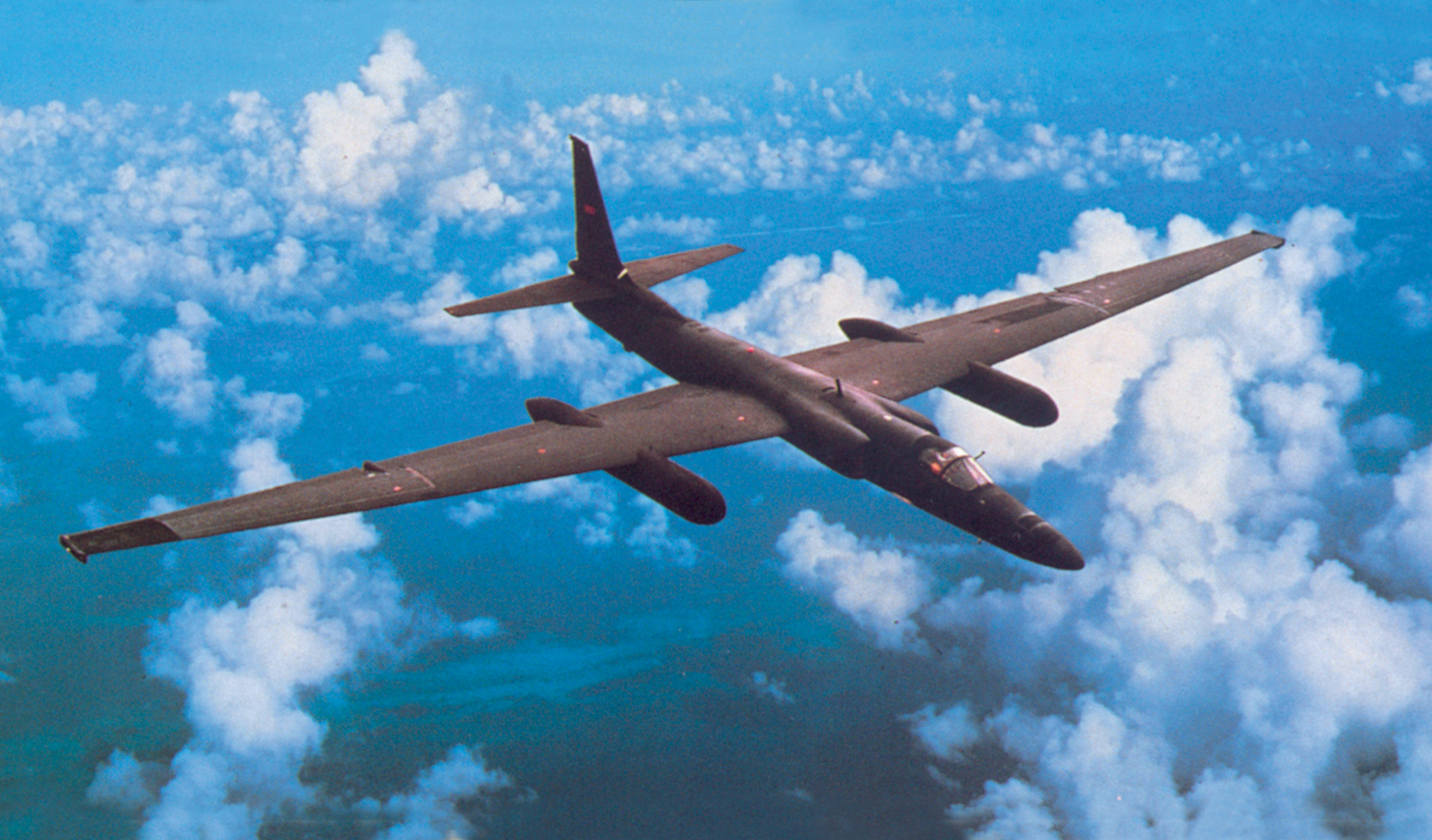
A U-2. Note the long and narrow wings, small fuselage, and short tail. Image Credit: Lockheed Martin
The SR-71 Blackbird
The U-2 flew high by being lightweight and efficient. In contrast, the SR-71 Blackbird flew high by burning 5,500 gallons of kerosene per hour. The SR-71 was built by the same Skunkworks division of Lockheed which built the U-2, and it had the same mission: to spy on communists. The goal of the SR-71 was to fly higher and faster than anything which could possibly shoot it down, and the plane achieved that. The Blackbird is a legendary aircraft and remains the fastest and highest-flying crewed aircraft (not including rocket planes) ever built, hitting 2,193 mph and 85,000 feet in level flight.
Lockheed started work on the SR-71 started in 1958 and it first flew in 1964. The aircraft has a number of unusual design features because of the stresses of flying at three times the speed of sound. Compression heated the air in front of the aircraft hot enough to melt aluminum, so much of the frame had to be made from titanium instead, which is a far harder metal to work with. The aerodynamic loads caused the aircraft structure to deform during flight. Most famously, the fuel tank was designed to seal properly when at operational temperature and under flight loads, and as a result it didn’t seal properly on the ground. While on the ground, the SR-71 would constantly leak fuel onto the runway or hangar floor.
The SR-71 was a marvel of engineering, but it might end up as an evolutionary dead end. The plane was extraordinarily expensive to build and maintain and it absolutely devoured jet fuel in flight. Many pilots who flew it have written memoirs. It is striking in their accounts how frequently the Blackbird needed to rendezvous with a tanker and refuel mid-mission. This expense meant the SR-71 performed much worse than the U-2 in the competition with drones and satellites. Supersonic reconnaissance aircraft just didn’t make economic sense once it became possible to fly dozens of drones for the price of a single SR-71. And across the board, supersonic military aircraft have gotten slower. The F-16, which first flew in 1974, can hit Mach 2, but the newest American fighter, the F-35, maxes out at Mach 1.6.4 Flying at supersonic speeds burns a ton of fuel, and flying at high Mach numbers sacrifices range, flight time, and maneuverability. The Air Force has found that even in combat situations, its pilots did not need speeds much above Mach 1.5, much less Mach 3.
In the last decade there has been quite a lot of effort put into developing hypersonic missiles, long range munitions which can hit speeds comparable to the SR-71 and maneuver better than ballistic missiles in order to evade air defenses. It is hard to find reliable information on their flight altitudes, though, and generally missiles want to fly low in order to stay out of view of radar. A few startups are also working on supersonic and hypersonic passenger aircraft, which would cruise at higher altitudes than existing commercial airliners. But commercial supersonic aircraft are still at an early stage, and success is not assured. I’m not going to cover those projects any further.
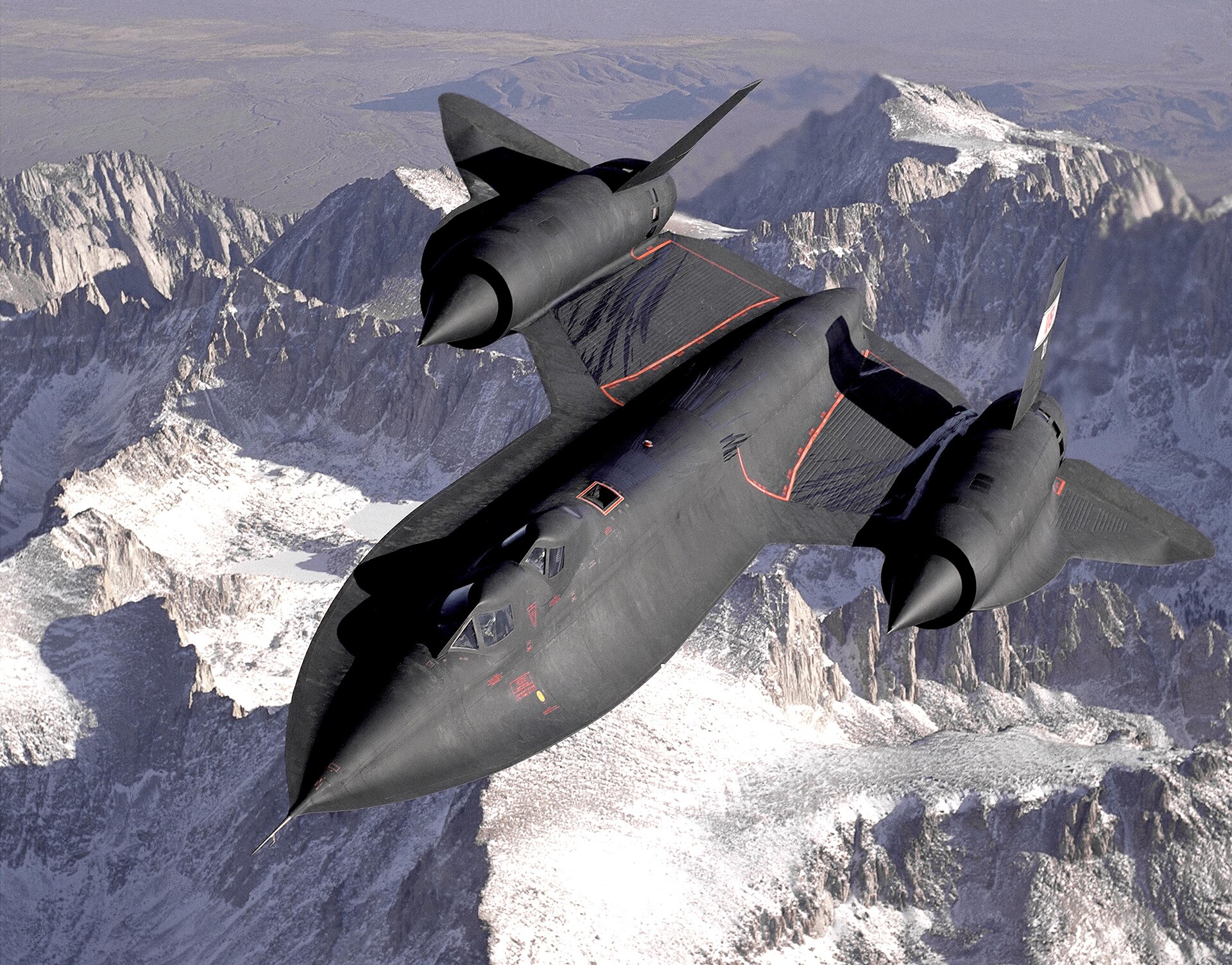
The SR-71. Note that the wing is short and fat to handle shockwaves, rather than long and skinny to maximize efficiency.
Balloons
The U-2 and the SR-71 each required billions of dollars and years of engineering work to create. In contrast, balloons are cheap and simple, and are the easiest way to reach the stratosphere by far. The obvious drawback is that without any way to propel themselves, a balloon will float freely at whatever speed and direction the wind happens to be blowing. With care and knowledge of prevailing winds, balloons can somewhat reliably be floated over an area of interest. But a single balloon cannot persistently cover an area or navigate from one area of interest to another.
The last two sections were about a specific plane, but this section is about a whole class of aircraft which vary widely in sophistication and size. Weather balloons are used to take atmospheric measurements across a range of altitudes and are typically small, simple, and oftentimes disposable. Communication or spy balloons, in contrast, can be large aircraft with capabilities comparable to a plane, and they can fly for months or years at a time.
A stratospheric balloon consists of a membrane, which contains the lifting gas, and a gondola that hangs from the membrane and holds the electronics and any payload. The term “balloon” can refer to the whole aircraft, or just the membrane and gas. The term “envelope” is also used in engineering contexts to refer to the membrane. The envelope is made from sheets of plastic film sealed together to form a gas-tight container. Simple balloons are made from latex or polyurethane, while polyethylene is the most common material for more sophisticated balloons. The envelope may consist of only an outer sheet of material, or it may have structural features like ribs or pressure management features like a ballonet or inner membrane. The lifting gas is usually hydrogen, particularly for short lifetime balloons, because it is cheap and lighter than helium. Some programs have used helium because it is easier to handle and safer and also because it is a larger molecule which means it leaks out slower than hydrogen does, which is valuable on long duration balloon flights.5
The pressure difference between sea level and the stratosphere means that the pressure of the lifting gas inside the envelope must drop as the balloon ascends, or else the balloon will pop. The usual approach is to inflate the balloon only partially so that the lifting gas has room to expand as the balloon ascends. Balloons may be neutral pressure, meaning the pressure inside the membrane is always equal to the pressure of the atmosphere, or super pressure, meaning the pressure inside the membrane is higher than atmospheric pressure. Neutral pressure balloons have slack in the envelope which allows the lifting gas to expand and contract as altitude and temperature changes. Super pressure balloons are more difficult to manage, but the internal pressure keeps the envelope rigid, which improves the aircraft’s aerodynamics and structural strength.
A gondola hangs from the balloon, carrying whatever payload the mission requires and the rest of the electronics necessary to fly the balloon. Weather balloons carry atmospheric sensors, measuring temperature, pressure, humidity, windspeed, and the like. Imaging balloons carry cameras, or more exotic sensors like hyperspectral imagers or radar. Spy balloons might carry receivers to collect radio traffic. A communications balloon can carry a point-to-point radio to create a high bandwidth link between two distant places, or it can act like a cell phone tower in the sky and connect to all devices in view. For a weather balloon, the only electronics necessary beyond the payload might be a battery and a radio. A more sophisticated balloon will carry solar panels to extend the lifetime of the vehicle and a flight computer to control it.
The most notable stratospheric balloon program was Google Loon, which was by far the best-funded and most ambitious attempt to use stratospheric balloons for commercial purposes. Between 2011 and 2021 Google attempted to create a cell network consisting of a fleet of high altitude balloons carrying cellular base stations. Aircraft can potentially provide connectivity to vast areas with low population density or in developing countries where it is uneconomical to build cell phone towers. Loon developed an extremely impressive vehicle and made many innovations in balloon design. Most significantly, they developed a variable density balloon which used a nested inner balloon to take in or expel ballast. This allowed the Loon aircraft to freely change altitude, despite not having propulsion. Loon’s thesis was that altitude control would also allow them to control the balloon’s position by catching winds blowing in different directions at different altitudes. The balloon wouldn’t be able to position itself precisely, but the idea was that a fleet of balloons would be able to navigate well enough with wind alone to provide continuous coverage of an area, and with an aircraft that was much cheaper and simpler than a powered aircraft. Unfortunately, Loon discovered that there were times of year where winds at all altitudes were aligned enough that the balloons could not keep their position this way. In particular, in their first deployment in Kenya there were times of year where Loon balloons would get blown out over the Indian Ocean and take months to navigate back. Loon eventually concluded they could not achieve persistent coverage with unpropelled balloons, and shut down shortly afterwards.
I think Loon conclusively showed that balloons aren’t viable for most communications applications. However, periods of no coverage are much less problematic for imaging and other data collection applications. Balloons are commercially used for aerial imaging at a modest scale by companies including Near Space Labs and World View. In this market, they compete against satellite imagery and aerial imagery from small planes, and there is space for all three types of vehicles because they fly at different altitudes and different cost points. And at least one government uses balloons for espionage. In the Chinese Spy Balloon Incident of 2023, the entire world learned that China uses stratospheric balloons for intelligence gathering when a balloon flew into US airspace. The Air Force tracked the balloon across the country then shot it down over the Atlantic Ocean. It was a strange sequence of events and had the feel of a mediocre knockoff remake of the Gary Powers U-2 shootdown.
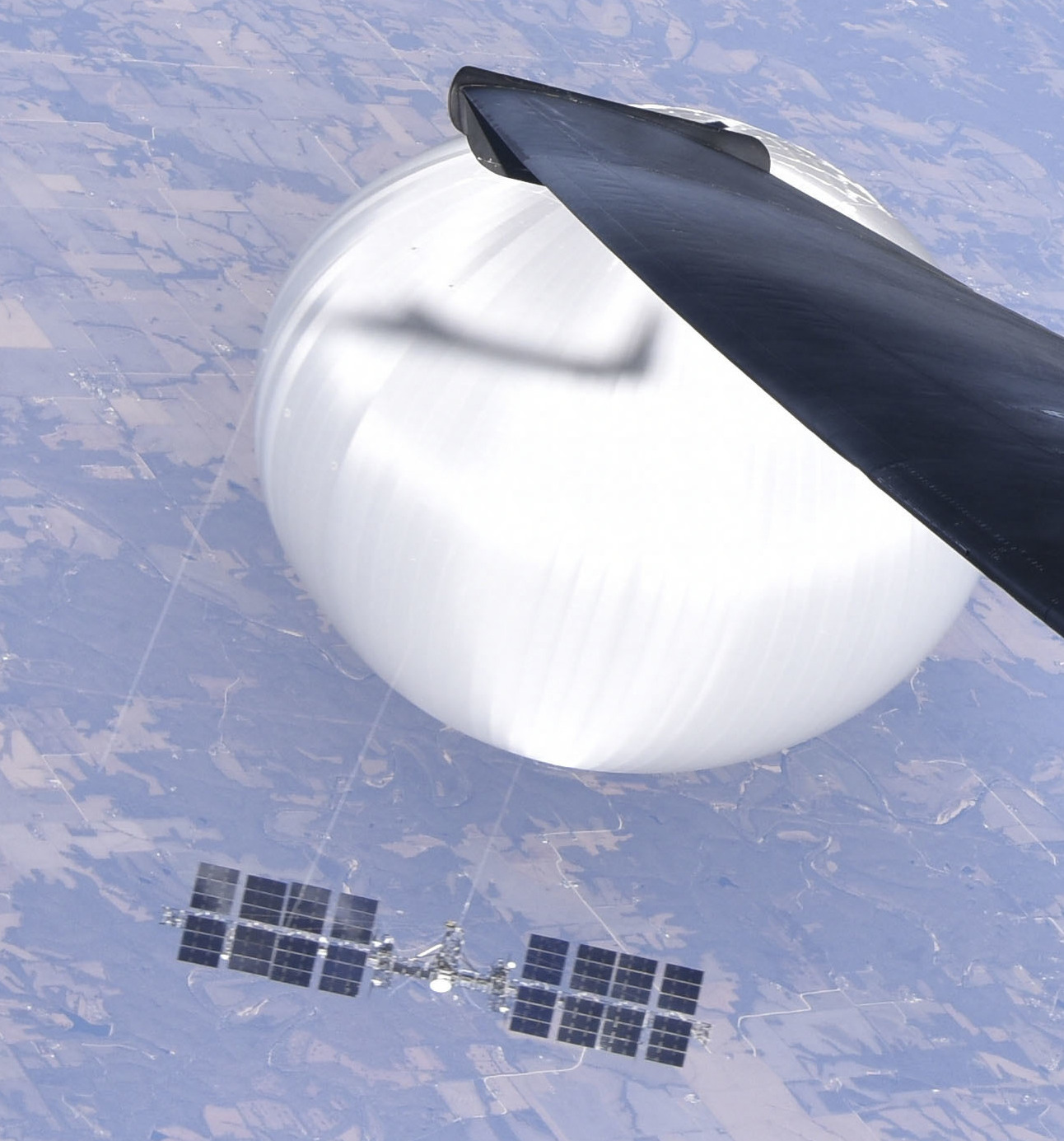
The Chinese Spy Balloon. Note the size of the solar arrays and complexity of the gondola. China initially claimed this was a weather balloon blown off course, which is laughable - this is a very sophisticated vehicle. This picture was actually taken by an Air Force U-2 (the black object is the wingtip), showing the spy plane’s usefulness. Image Credit: US Department of Defense
There’s one last application for high altitude balloons which is a bit stranger: Tourism. A few stratospheric balloons have been crewed, carrying people to the stratosphere for extreme skydiving stunts. The Red Bull Stratos project got the most attention, dropping Felix Baumgartner from 128,000 feet in 2013 and setting the record at the time for highest sky dive. Some people have attempted to build larger versions of these crewed stratospheric balloons in order to sell flights on them to tourists. Flying to the stratosphere would be a unique experience. The passengers would spend hours looking down at the landscape below them at an altitude high enough that the sky becomes black and the curvature of the Earth is visible.6 A few companies have worked on this idea, though none have gotten very far. Space Perspective is trying to build a crewed capsule, and World View was initially a tourist balloon company before pivoting to imaging. I suspect this is a viable business but difficult to do. Blue Origin and SpaceX have shown that there is a market for tourist flights on rockets, despite the high cost. A stratospheric balloon would be similar; the ticket would probably be cheaper and the ride would be longer, though the passengers don’t get to go to space. But the market is probably not huge, so we may or may not see an aircraft like this fly in the next decade or two.
Balloons are a fairly mature technology, which means both that they have proven there are things they are good at and that they probably won’t find many new applications in the future. They’ll continue to be used for imaging and atmospheric sensing, but probably won’t be used for communication. Their simplicity is both their biggest strength and biggest weakness, making them easy to fly but less useful than a stratospheric aircraft that could control its own position.
Future Stratospheric Aircraft
The two spy planes both flew high in order to take pictures over hostile territory without getting the pilot killed. But as mentioned, technological change has made them obsolete. The same mission today is done more cheaply by satellites, safely outside of the atmosphere, and by drones, which fly without risking a pilot. And it isn’t worth the cost or effort to try to protect a spy drone by flying it in the stratosphere.
The people who work on stratospheric flight today do so for a different reason: The calm air means an ultra-long endurance aircraft could stay aloft in the stratosphere effectively forever. This sort of aircraft could do the missions that balloons do, and with the ability to maneuver, possibly much and more. The longer an aircraft can stay in the sky, the more valuable it is for observation or communication, and a forever-flyer could permanently cover an area with an observation or communication payload.7 An aircraft like this has been on the edge of technological viability for the last few decades, and as solar panels and batteries have gotten better, forever-flyers have inched closer to operation.
The U-2 can stay aloft for 12 hours on one tank of gas. Refueling in flight can extend the endurance of a gas powered plane further, but only at great expense. And the limits of human endurance mean that pilots can’t fly much more than 12 hours, anyway. So a forever-flyer needs a way to generate energy without landing, which means solar power, and it needs to be autonomous, rather than piloted
These aircraft collect energy during the day with solar panels mounted on the upper surfaces of the vehicle, and store energy overnight in batteries. The solar energy powers engines to stay in flight, navigate, or hold position over a target area. The aircraft must have enough solar panels to generate power sufficient to overcome the wind over the course of a day, and it must carry enough batteries to operate through the night without fully discharging. These are difficult engineering requirements to satisfy.
Very efficient subsonic planes and blimps are both viable approaches to building a forever-flyer. Serious efforts have been made to build both types. I’ll cover forever planes in the next section, then in the last section, forever blimps. I’ll cover the major design and operational considerations for each, then describe the most significant programs which are working on each.
Forever Planes
The U-2 is the pinnacle of “conventional” stratospheric plane design, optimized to generate enough lift to stay up in the thin air of the stratosphere. But continuous flight adds a new constraint - in addition to generating enough lift to stay aloft the aircraft can only use as much power as onboard solar panels can generate. So the aircraft must be optimized both to maximize lift and to minimize power consumption. The best way to reduce power consumption is to fly slower. We previously assumed that a subsonic stratospheric aircraft flies as fast as it can without breaking the sound barrier, but a forever-flyer cannot do this. Unfortunately, per the $v^2$ term in the lift equation, lift is proportional to the square of velocity, so flying slower reduces lift quite a bit. Lift must still equal weight, however, so a forever-flyer must compensate by pushing the wing loading even lower and pushing the wing aspect ratio even higher.
A normal plane consists of a wing, a body (or fuselage), and a tail. In a normal plane the fuselage contains the fuel, crew, passengers and cargo - most of the plane, and most of its weight. But a forever-flyer can barely afford a fuselage at all. Instead, the plane is almost entirely wing. Some designs have a short and narrow fuselage, just enough to attach a small tail. Some designs take things to their logical conclusion and build “flying wings,” aircraft with no fuselage or tail at all. A flying wing has the lowest wing loading of any aircraft architecture, but the tradeoff is that it’s very difficult to control a plane with no tail. This seems to have been a contributing factor to several of the crashes we are about to talk about.
After maximizing wing area, weight is minimized. The aircraft structure is made mostly from composites and foam rather than aluminum. Batteries are packed into the interior of the wing and do double duty as part of the load-bearing structure. And these aircraft use exotic solar cell and battery chemistries which are more weight-efficient than typical utility solar panels and batteries.
The third step is to maximize the wing aspect ratio. This goal, unfortunately, directly conflicts with minimizing weight, because a long and thin wing needs structural mass to keep itself stiff and in one piece. But a forever-flyer cannot afford too much structure, and so the wing is neither as stiff nor as strong as the structural engineers would like it to be. This results in large wing deformations and novel failure conditions, as we will see. This lack of structure also means the aircraft needs to have an even lift and weight distribution along its wingspan, and cannot carry a heavy point load without deforming. General aviation and commercial aircraft typically have wing aspect ratios between 5 and 10. Forever-flyers achieve aspect ratios of around 30.8
These design constraints produce strange aircraft. They are some of the most sophisticated aircraft ever built and are tremendous achievements of aeronautics. But they are also awkward, unwieldly, fragile, and very hard to get right.
The pioneer of solar flight is the company AeroVironment. AeroVironment built the first plane to fly entirely by human power, the Gossamer Condor in 1977.9 A plane that could fly on human power could also fly on the power provided by 1970s-era solar panels. So AeroVironment developed and flew the Gossamer Penguin in 1979, and followed that with the more capable Solar Challenger in 1980. In 1981, the Solar Challenger flew 163 miles across the English Channel using only solar power, demonstrating that it was a real and capable aircraft, and not merely a gimmick. Two solar planes flew before AeroVironment: the uncrewed AstroFlight Sunrise made the first-ever solar powered flights in 1974, and the Mauro Solar Riser made the first crewed solar flights in 1979, beating the Gossamer Penguin by two weeks. But AeroVironment, in partnership with NASA, would drive solar aviation forward.
In the 1990s NASA ran a program investigating the use of high-altitude and slow-flying aircraft for data collection.10 As part of that effort, they partnered with AeroVironment to build three solar powered stratospheric aircraft of steadily increasing size and complexity: NASA Pathfinder, NASA Centurion, and finally and most importantly, the Helios Prototype. Helios is a bizarre airplane. It is a flying wing, a long, straight, rectangular airfoil, with solar panels mounted on top and propellers along the leading edge. The wing is not rigid. On the ground it lies flat, but in flight the structure flexes to form a distinctive droopy U shape, an amount of deformation which is unsettling to see as an engineer. Helios has a wingspan of 247 feet, wider than a Boeing 747, but weighs only 2,048 lbs, or about 1/500th of the 747.
Helios flew successfully for several years and demonstrated that stratospheric solar powered flight is possible. The program had two goals: to demonstrate extremely high altitude flight, and to demonstrate extremely long-duration flight. It accomplished the first but failed the second. Helios reached an altitude of 96,863 feet in 2001, setting the world record for the highest steady, level flight, which it holds to this day. After that test campaign, the aircraft was reconfigured for long-duration flight, with the goal of flying for multiple days. But instead it met its demise, inadvertently demonstrating the fragility of stratospheric planes. In June of 2003, during a checkout flight off the coast of Hawaii, the Helios Prototype hit a patch of turbulence at 3,000 feet. The turbulence pushed the aircraft into a roll, and it entered a downwards spiral that it could not recover from. As it descended it disintegrated under aerodynamic loads, and the debris fell into the Pacific. This disaster ended the Helios program.
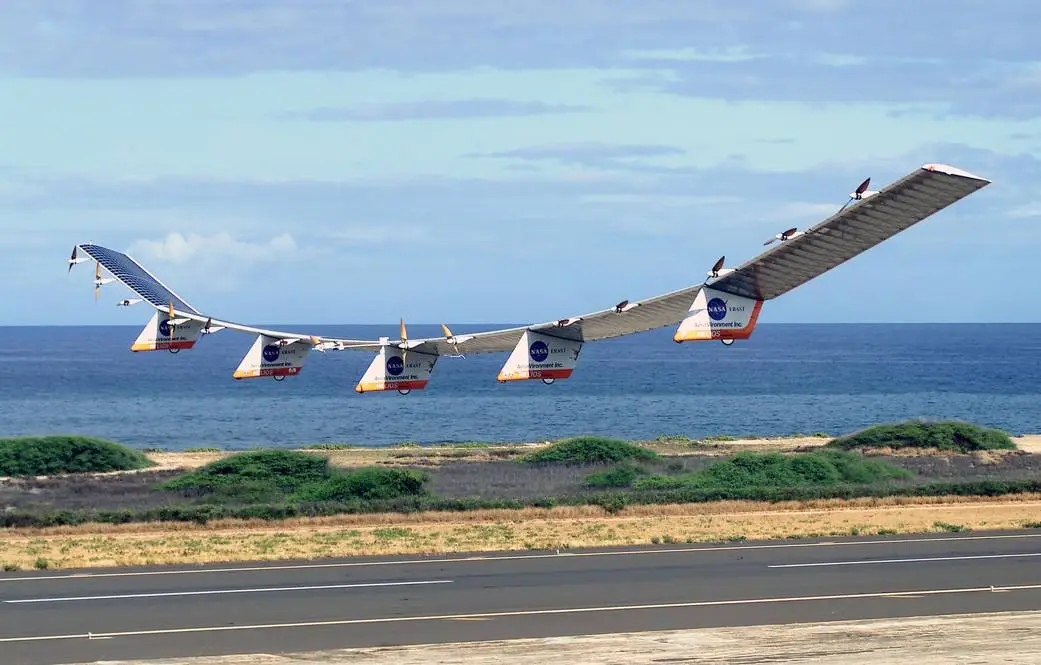
The Helios Prototype just after takeoff. Image credit: NASA
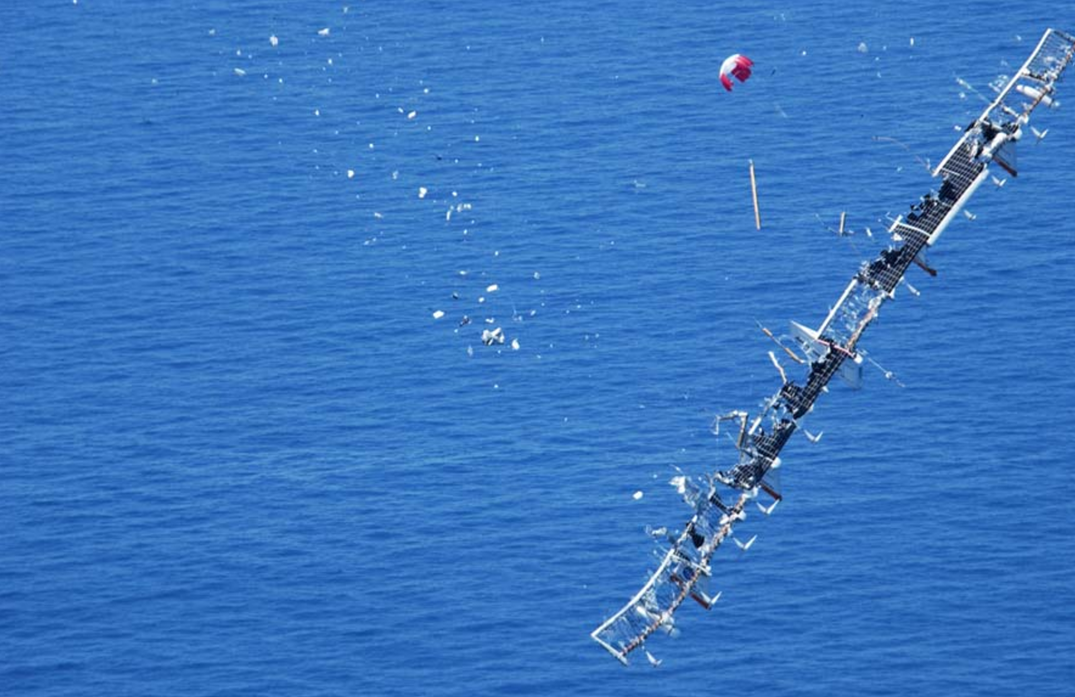
Helios in the process of disintegrating after entering a spiraling dive. Image Credit: NASA
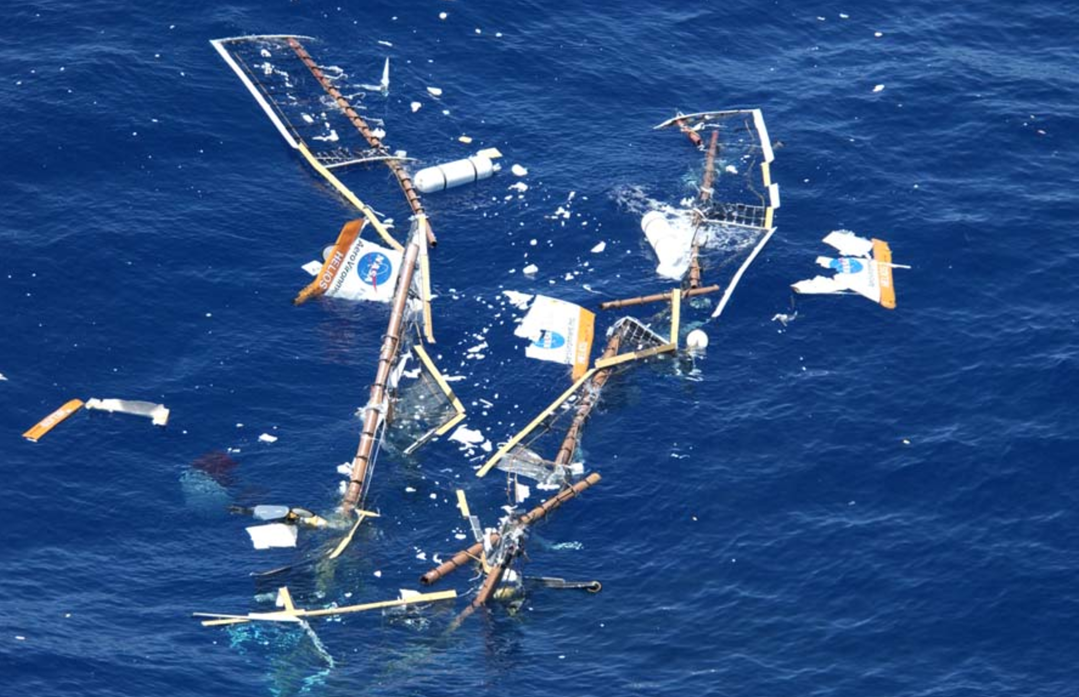
The wreckage of the Helios Prototype floating in the Pacific Ocean. Image Credit: NASA
The issue is that the lightweight, high aspect ratio wings that are needed for continuous stratospheric flight can be destroyed by aerodynamic loads that a normal aircraft would easily handle. Extra structural mass to strengthen the wing comes at the cost of sacrificing endurance and maximum altitude. Turbulence can be scary to passengers, but airliners can fly safely through all but the very worst storms. But stratospheric planes cannot. Wind even on apparently calm days can push the aircraft to an orientation or speed that it can’t recover from. Forever-flyers are usually safe in the calm air in the stratosphere, but ascent and descent is dangerous, and high altitude storm systems sometimes push into the stratosphere to threaten cruising aircraft.
NASA is a research organization, so its job was done once Helios demonstrated the possibility of solar flight. Further progress would be made by private organizations attempting to build a plane that could do something useful for a customer. The most important modern solar plane is Zephyr, produced by Airbus. Unlike Helios, Zephyr is not a flying wing, and instead has a tail attached to a short spar. Zephyr is also much smaller than Helios, with a wingspan of 82 feet and a weight of only 165 pounds. The aircraft has been in development for a long time: the first version of Zephyr flew in 2005, built by QinetiQ, a British defense contractor. In 2010 a Zephyr flew for 14 days, setting the world record for the longest continuous flight, and its current record is 64 days. In 2013 the project was acquired by Airbus, who have continued development and commercialization attempts.
When an aircraft crashes there is often an accident report that makes information public that would otherwise be hidden. There are three Zephyr crashes in the public record. For the first in March 2019, there are only brief comments that suggest the crash was caused by weather. The second crash happened in September 2019 when a Zephyrs failed during ascent in a crash that closely resembled the accident that destroyed Helios. The plane hit turbulence and rolled several times until it it entered a downwards spiral and broke apart. The third Zephyr accident happened in 2022 and was caused by an engine failure rather than a control failure. Comments from Airbus say that the aircraft was running at full power for an extended duration to stay above unusually high-altitude weather and something in the engine broke, causing the plane to lose thrust and crash. These crash reports give some texture to Zephyr’s development and narratives of how stratospheric airplanes fly and how they fail. It is notable, though, that none of these crashes seem to have slowed down the program down.
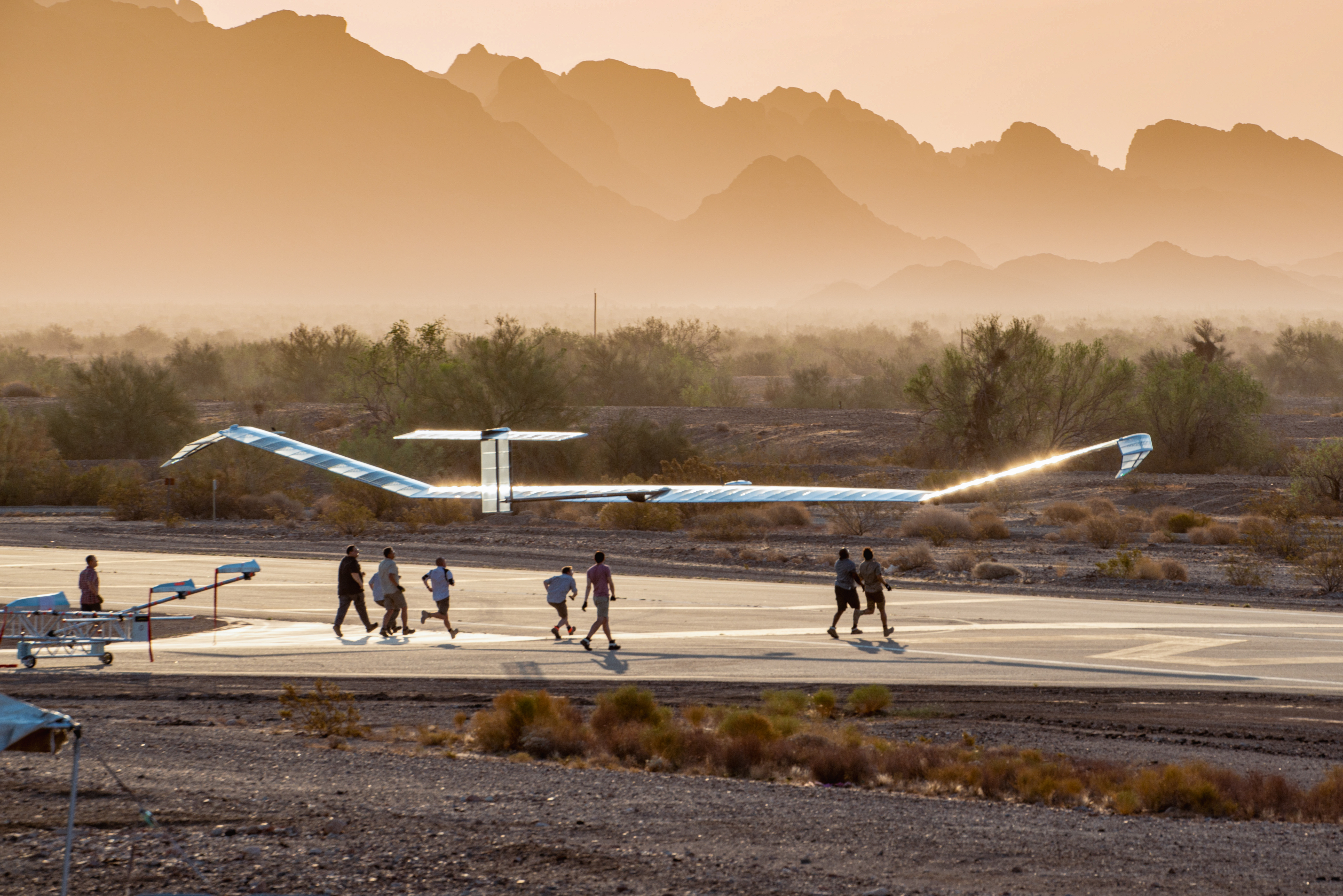
Image of Zephyr just after takeoff. Photo credit: Christian Otto via Airbus.com
A second stratospheric plane that is currently flying is PHASA-35, produced by BAE Systems, a British defense contractor. The PHASA program shares heritage with Zephyr and is run by former QinetiQ engineers who left after Zephyr was acquired by Airbus. As a result, PHASA has a very similar design except that it is about twice as big. It has a much shorter operating history, though it has importantly reached 60,000 feet and flown for 24 hours.11 BAE has stated that it aims to get the PHASA-35 operational by 2026.
Zephyr and PHASA are both built by defense contractors and they appear to be aimed at government customers. The plan seems to be to build and sell the aircraft, probably in small quantities, and for the government customer to then fly the plane for their own purposes, which is the typical business model of a defense contractor. Several other companies have tried to build stratospheric planes with the intention of operating the aircraft themselves and selling connectivity, rather than selling planes. This is the business model that Google Loon tried to do with balloons, and three other programs have taken a shot at it with planes.
During the exuberance of the 2010s, Facebook and Google used some of the cash that their primary businesses generated to try to get into the stratospheric internet business. Google briefly ran a second stratospheric internet project alongside Loon. In 2016 they acquired an American stratospheric plane startup called Titan Aerospace. Titan’s aircraft was similar in design to Zephyr, with a small tail, and midway between the size of Zephyr and Helios at 870 pounds and a 165 foot wingspan. The plane flew only once, in 2015, in a test flight that lasted only four minutes. According to the accident report, several minutes into flight the plane hit an area of thermal updraft and accelerated upwards, climbing 135 feet in a few seconds. The updraft accelerated the aircraft above its airspeed design limits and aerodynamic forces broke the left wing off, causing the plane to crash. But that flight was enough to convince Google to acquire them. The program ran for a year under Google until it was shut down in 2017 without further explanation and without attempting a second test flight. My understanding is that a new Google CFO at that time, Ruth Porat, was trying to reign in some of Google’s excesses, and Titan ended up in her crosshairs. But it’s an unsatisfying conclusion, and it is not clear what lessons, if any, should be taken from the program.
Facebook’s project was called Aquila. Aquila was a flying wing like Helios, about half its size, and roughly the same size as Titan with a weight of 937 pounds and a 140 foot wingspan. The plane flew twice, a first flight in 2016 which ended in a crash, and a successful second flight in 2017. On approach to landing during the first flight, a gust of wind pushed the aircraft above its glide path. The autopilot pitched the nose of the aircraft down in an attempt to correct this, which increased airspeed, then pitched back up once it was back on the glide path. Unfortunately, the aerodynamic load during this maneuver broke the right wing, and the aircraft crashed.12 It is somewhat remarkable that this maneuver sufficient to destroy the aircraft. It is very difficult (though not impossible) for a plane to destroy itself by maneuvering, but normally a dangerous maneuver would be much more violent. The crash did not quite end the program and a second aircraft was built, flown, and landed. In each flight Aquila appears to have hit around a kilometer in altitude and flew for a few hours. There is publicly available footage of the plane landing from the second test flight, and it’s spectacular (though a little clumsy on the ground). Despite the success of the second test flight, Facebook cancelled the program shortly afterwards, again for reasons which are not entirely clear. Presumably, like Google, Facebook management decided the project was too risky or not worth the capital that would be required to get to operation.
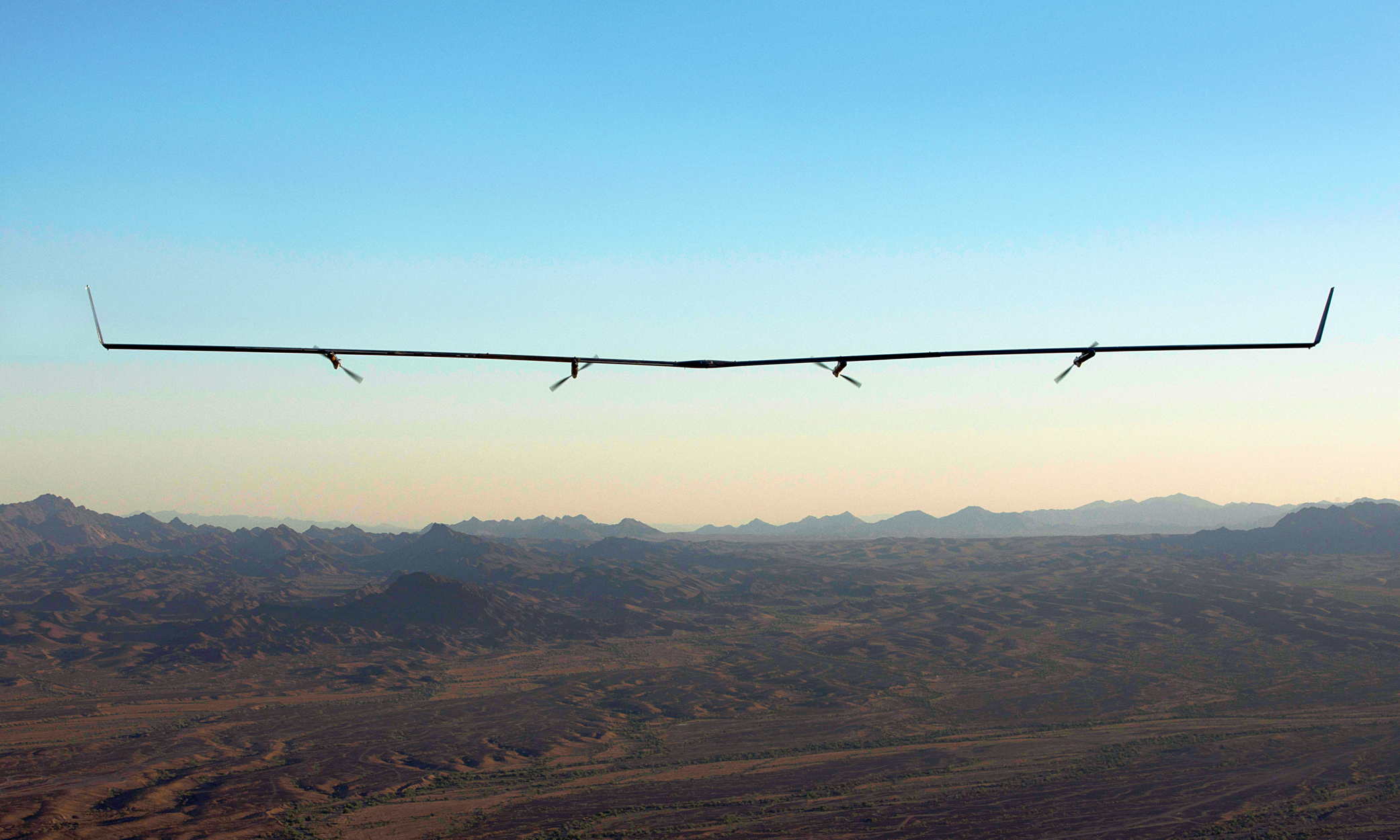
Image of Facebook Aquila in flight, head-on view. Photo credit: Meta
One final stratospheric internet program is still active. AeroVironment has tried to capitalize on the development work it did on the Helios Prototype by partnering with SoftBank, a Japanese telecommunications conglomerate. In 2018 the two started HAPS Mobile, a subsidiary of SoftBank that aims to provide stratospheric cell coverage. In November of 2020 the company made a test flight of their prototype, called Sunglider, from New Mexico. A press release claims they flew for 20 hours (not quite overnight) and reached 62,500 feet, and flight footage released by the company supports those claims. Sunglider has a takeoff weight of 165 pounds and a wingspan of 256 feet, putting it in the same size class as Zephyr and PHASA. The company continues work on the program, and made a second test flight in October 2024. I think it could go either way. They haven’t moved very quickly, and haven’t made enough progress for me to be confident they are on firm footing, but they’ve also made it to the stratosphere, and very few programs have gotten that far.
One observation is that these aircraft widely vary in size, and the smaller three aircraft are still flying while the larger three aircraft are not. Facebook, Google, and NASA all flew only one aircraft at a time, and crashed it. This immediately ended NASA’s program, and though we don’t know for sure, almost certainly was a major reason Facebook and Google cancelled their programs. Airbus Zephyr, on the other hand, has crashed at least three aircraft, but the program continues. It seems inevitable that prototypes will crash during development of a solar plane, and if the aircraft is smaller a crash is less expensive and the program is more likely to survive. I am curious what factors drove the sizing of Titan Aerospace and Aquila. Perhaps they had valid reasons to believe they needed that larger payload to be economically viable. But with the benefit of hindsight, it certainly seems prudent to design a smaller aircraft so that prototypes may be more easily replaced.
Blimps
And finally, airships. Stratospheric airships can be understood as the next step up in complexity and capability from stratospheric balloons, and much of what I covered in the balloon section applies equally to airship. The difference is that an airship has propulsion and can therefore maneuver against the wind and control its position. Adding propulsion is no small thing and requires much more power and more structure than a balloon of equivalent size. But maneuverability also makes the airship much more useful. A solar blimp ought to have comparable capabilities to a solar plane, and be capable of doing the same missions. As we’ll discuss, they each have their advantages and it’s not clear yet which is the better approach.
The simplest way to create an airship is to take a balloon and attach a propeller to the gondola without changing anything else. Google Loon tried this: they built and briefly flew a version of their balloon with a propeller. But Loon concluded propulsion wasn’t useful on an unmodified spherical balloon. A spherical balloon experiences much higher drag than a streamlined shape, and the limited maneuverability of such a vehicle was not worth the effort, despite its simplicity. I think that experiment is enough to conclude that a stratospheric airship must be streamlined to be viable. This can mean an envelope that still basically looks like a balloon but is football-shaped, or an envelope with the classic bullet-like airship shape.
The major elements of a blimp are the same as a balloon: an envelope made from sheets of plastic film and a gondola carrying the electronics. Airships are always super pressure because rigidity is necessary to fly against the wind, which makes managing envelope pressure during ascent harder. An airship that was launched partially-inflated would lose rigidity during ascent and need to achieve its final shape at altitude, so it may be appealing to launch fully inflated and vent lifting gas instead. A super pressure airship is also very difficult to land. It would be awfully nice to be able to land the large and expensive aircraft back at its hangar, but the only ways to descend are by reducing lift by venting gas or increasing mass by taking on air as ballast. Neither approach is particularly appealing. Venting is easier but would cause the envelope to lose rigidity, making it difficult to control and possibly damaging it. Taking on ballast requires carrying pumps and other gas-handling equipment, which reduces the weight available to a payload.
Less work has been done on stratospheric airships than stratospheric planes. Early work focused on airships as a way to carry large aperture radar dishes to an altitude where they could see over terrain. Raven Aerostar, an American manufacturer of blimps and balloons, was the first to fly a stratospheric airship in 1969, and the US Army conducted a test flight in 2005 of a stratospheric airship that was also manufactured by Raven Aerostar as part of a program called HiSentinel. Both flights reached 70,000 feet but lasted only a few hours, and it’s unclear exactly how well the aircraft functioned at altitude. Lockheed Martin has run several high altitude airship programs over the decades, which culminated in a test flight of a prototype called HALE-D in 2011. But it experienced some sort of technical failure during ascent and landed in a forest near Pittsburgh in what Lockheed called a “descen[t] without incident” but what I might call a crash followed by the wreckage catching on fire. This work on free-flying airborne radars never amounted to much, though tethered radar blimps (called aerostats) were more successful and have been used to watch the US southern border since the 1980s. I’m going to discuss two other projects in detail: Google Hammerhead, which is defunct but published quite a bit of valuable information, and Sceye, which is the only significant ongoing stratospheric blimp program.
In the waning days of Google Loon the company searched for ways to solve the problem that would prove fatal: At certain times of year balloons would get blown from Kenya out over the Indian Ocean and take months to return. They revisited the idea of adding propulsion to their aircraft and developed a vehicle concept called Hammerhead. Hammerhead streamlined the envelope and made the gondola much larger, creating a vehicle which still looked similar to a balloon but which would have been capable of steering against the wind well enough to shorten the return journey when blown off station. Engineers at Loon projected that a small fleet of these aircraft would be economically viable, and would have been capable of making the stratospheric connectivity use case work. But the hour was late, and the bell tolled for Loon before that work could come to fruition.
Hammerhead is tantalizing because Loon engineers quite explicitly predicted it would work:
Internal estimates suggest that such a vehicle would cost 5x to 10x as much as Loon’s latest pumpkin balloons but would shrink the fleet size by an even larger factor and, because of increased utilization and increased capacity when utilized, it may earn about 10x to 50x as much revenue during its lifetime. - The Loon Library, page 351
This prediction was based on system-level design work and we shouldn’t overstate the level of certainty possible in early analysis of a vehicle that hasn’t flown. But the team that made this prediction had been developing lighter-than-air aircraft for a decade and had a very mature understanding of vehicle design and a sophisticated set of system analysis tools. There appears to be an opportunity here to pick up where Loon left off - every attempt to build a novel aircraft is extremely risky, and this is actually a very unusual amount of substantial prior work predicting this concept will work
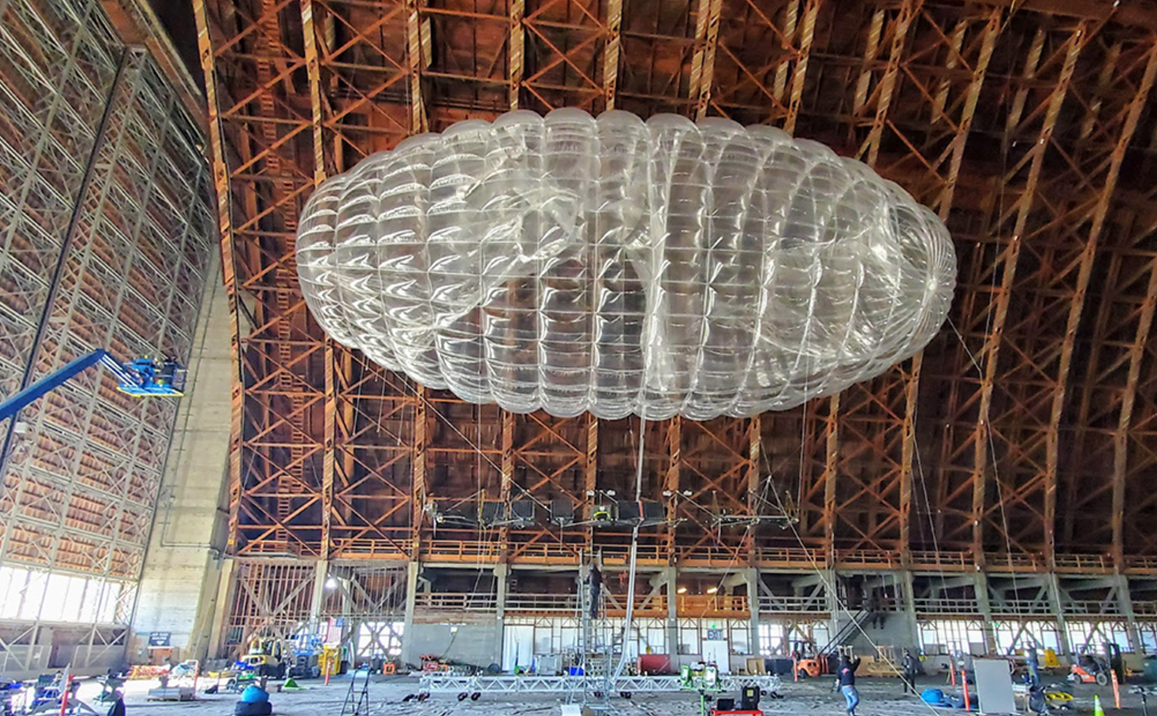
The Hammerhead prototype built by Google Loon, shown in a hangar at Moffett Field in California. The gondola is hanging below the envelope, though it is a bit difficult to make out against the background. Photo credit: Loon
There is only one significant ongoing stratospheric airship project, but it appears well funded, and it has gotten the furthest of anyone who has attempted to build this sort of vehicle. Sceye (pronounced “sky”) is a U.S. company, based in New Mexico, which is developing a stratospheric airship for unspecified connectivity or observation applications. Their aircraft looks like a blimp made out of tin foil, with solar panels on top and propellers mounted directly to the envelope rather than on a dangling gondola.
Sceye has conducted a number of test flights, though they haven’t released as much information publicly on their flights as I would have liked. They claim to have conducted 20 test flights and have released information about three of them: a first flight in 2021, a flight in 2022 which they released video of the launch, and a long-duration flight on August 15th, 2024. They report that the August flight lasted for 29 hours, reached 60,000 feet, and landed afterwards. This is an impressive aeronautical achievement and very promising, though I find myself wanting more detail to verify how well the aircraft worked. For instance, the company didn’t specify what condition the aircraft was in when it landed. I know through secondhand reports that Sceye has had at least one failure during ascent, and the company has not released any video from the aircraft at altitude or on landing. But regardless, Sceye seems to be making progress and they may make it to commercial operations in the next few years.
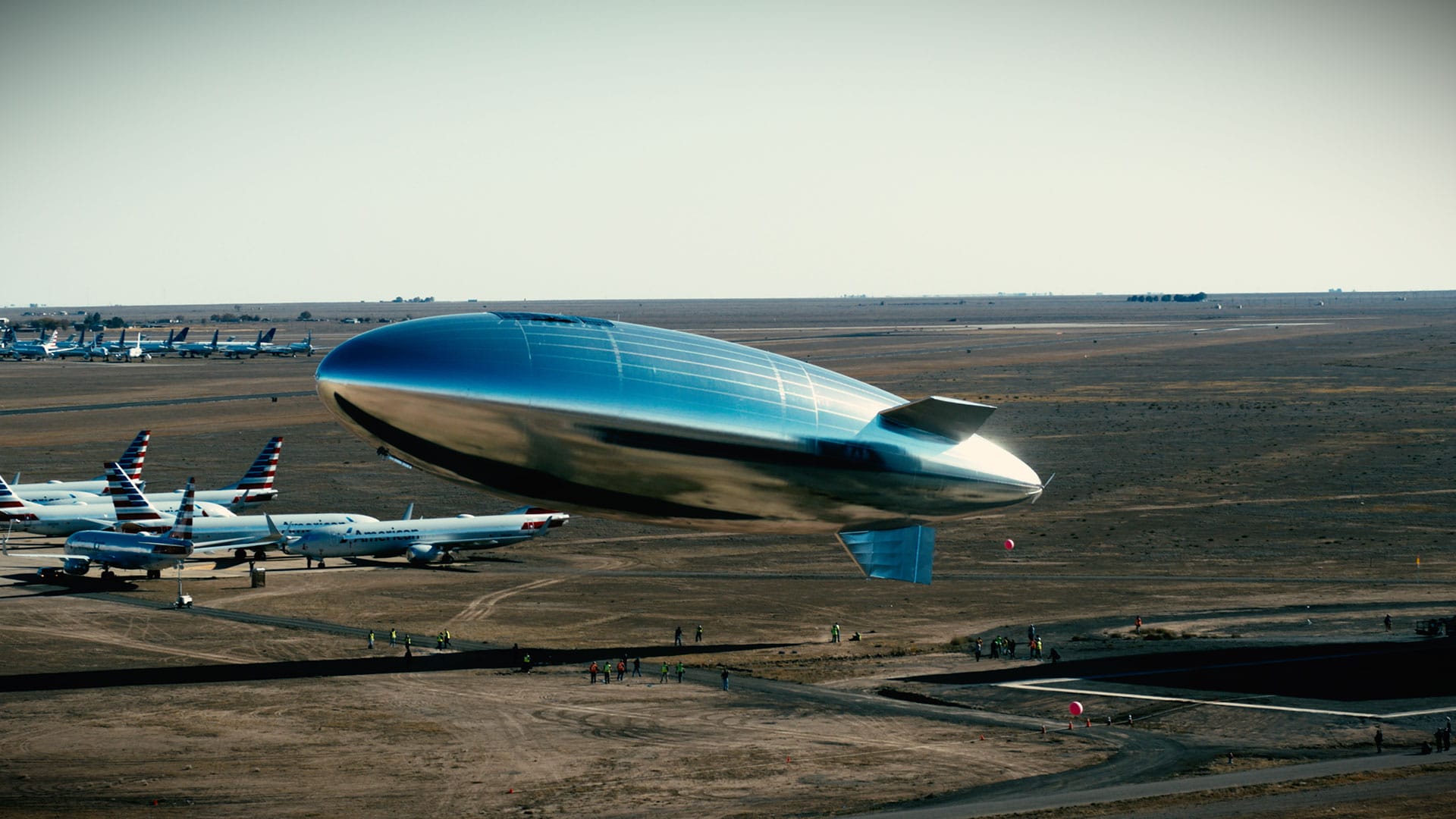
Sceye’s airship just after release in New Mexico. Solar panels are visible on the top of the aircraft, and the propeller is visible at the rear. Photo credit: Sceye
It’s not clear yet how well stratospheric airships compare to stratospheric planes. Roughly speaking, blimps should be easier to control and to keep in the air but slower, more difficult to keep in position in high winds, and more difficult to land. Buoyancy makes blimps resilient to turbulence and to operational problems that interrupt power to the propulsion because buoyant lift, unlike aerodynamic lift does not depend on forward level motion.13 Planes, in contrast, can change altitude freely and land more easily, and they have much smaller frontal areas, requiring less power to fly against the wind. Both types of aircraft appear capable of holding position indefinitely in typical stratospheric conditions. As I mentioned, there have been many fewer stratospheric blimp programs than stratospheric plane programs. But I suspect that’s simply because planes are far more common generally and the first thing that comes to mind. It remains to be seen which approach to forever flight will be the first to work.
Looking Forward
So as things stand in 2025, there are four programs that are currently testing solar-powered stratospheric aircraft. Airbus Zephyr appears ready for operations, BAE PHASA-35 is perhaps getting close to ready, and Sceye and HAPS Mobile are both making test flights but probably have a long way to go. Improvements in batteries, solar panels, and composite materials will continue to make stratospheric aircraft easier over time. New development programs may emerge: there are a few startups that I did not include in this piece because they are too early stage to cover in detail, and one or more of those may reach flight testing. The next major step forward would be for a stratospheric aircraft to start making regular flights and getting paid for them. It’s a bit surprising that Airbus Zephyr has not done this already, although I suppose it is always possible they are flying missions for some government that they haven’t publicized.
If I had to put odds on it, I would guess there is a 60% chance that a stratospheric forever-flyer enters sustained commercial operations in the next ten years. I think there are three possible outcomes. The pessimistic outcome is that stratospheric aircraft never end up in regular use, either because in practice they cannot complete a useful mission because of some technical limitation, or because it turns out they cannot do so economically. The intermediate outcome is that forever-flyers become a specialty aircraft, used for a few niche applications which their performance characteristics are most valuable, but not in great numbers. The optimistic outcome is that forever-flyers become widely adopted for some application and many hundreds or thousands fly each day. Particularly if someone makes stratospheric connectivity work, we could see thousands of stratospheric drones flying every day as telecommunications infrastructure. I’m obviously rooting for the third outcome. I find these aircraft fascinating and I hope the future contains lots of them.
-
These values are from the International Standard Atmosphere.. ↩
-
Technically, $A$ is a reference area which can be chosen to be any area defined by the the object’s geometry, and the value of the coefficient of drag is partly defined by that choice. By convention, the reference area for an aircraft is always the wing area, but for other types of object different areas are used. Drag coefficients can only be directly compared between different objects if the reference area is chosen consistently between the two. ↩
-
I thought at first that the date of this flight was an intentional middle-finger to the Soviets, but according to the account given in A Brotherhood of Spies, the timing was driven by Eisenhower’s hesitation to authorize the violation of Soviet airspace. The U-2 was ready by the winter of 1955-56 and had been making test flights, but Eisenhower worried about the diplomatic risk of flying into communist territory. He finally gave approval for a flight within a certain window over the summer, and July 4th was the first day of that window where the weather was good enough to fly. The book is excellent and I highly reccomend it to anyone who wants to know more about the U-2 Program ↩
-
Supersonic speeds are commonly measured with “Mach numbers,” which are the ratio of the airspeed to the speed of sound. Mach 1 is the speed of sound, Mach 2 is twice the speed of sound, and so on. Mach numbers are used rather than miles per hour because the speed of sound varies with the air temperature and composition, and because many aerodynamic phenomon depend on the speed relative to the speed of sound, rather than absolute airspeed. ↩
-
Though the danger of using hydrogen lifting gas is quite overrated. ↩
-
This has lead to an annoying trend where this is described as a “space balloon” or, worse, a “spacecraft.” Those highest skydives were about 40% of the way to space, which is impressive, but still deep in the atmosphere. ↩
-
There isn’t a great name yet for this sort of aircraft. The acronym HAPS is probably the most common, which stands for High Altitude Pseudo-Satellite, or alternatively High Altitude Platform Station. HALE is also sometimes used, for High Altitude Long Endurance. I think both are pretty clunky acronyms, though, and prefer the term forever-flyer until a better name presents itself. ↩
-
Though this is not actually the highest aspect ratio of any aircraft - some high-end gliders achieve wing aspect ratios as high as 50 because they can afford additional structural mass. ↩
-
It’s not entirely clear to me why. It seems that the founder and chief designer, Paul Macready, decided that his life’s work was building niche ultralight planes, and a human powered plane was a challenge which captures the imagination. ↩
-
The generically-named “Environmental Research and Sensor Technology” program, or ERSAT, started in 1994. ↩
-
It’s not clear if it did both of these in the same flight, however. ↩
-
The only good link to the NTSB report I could find is an autodownload of a PDF - NTSB Report. ↩
-
Turbulence might still be an issue - an airship envelope is thin and hypothetically could be ruptured by aerodynamic forces, but I don’t have a sense of how bad turbulence would need to be to do this and it might be the case that an airship will never encounter sufficiently bad turbulence in practice. ↩